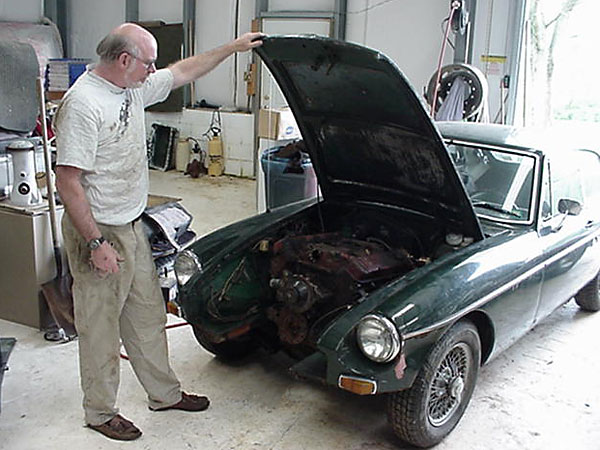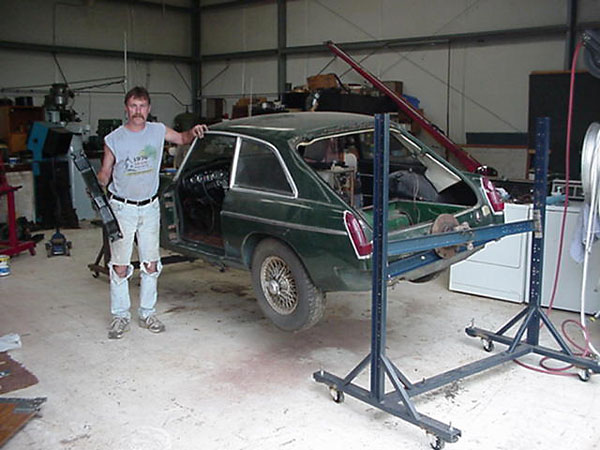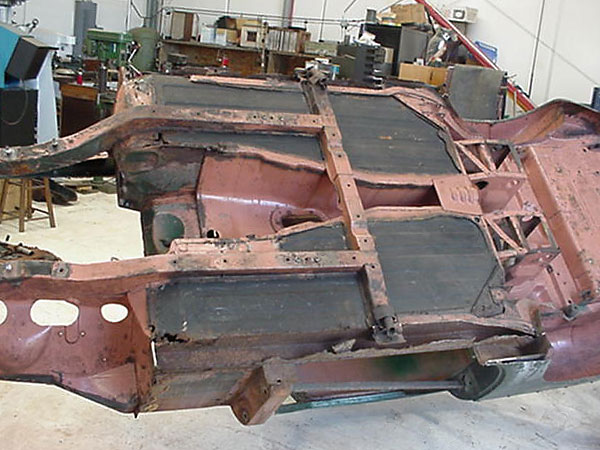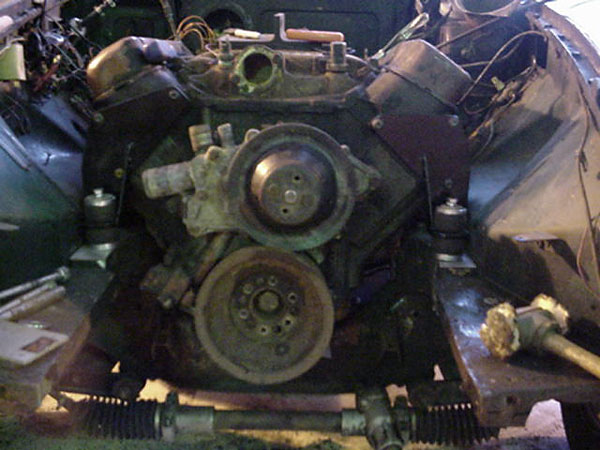
MGB Roadmaster (aka "Project BADASS")
as published in British V8 Newsletter, Volume XV Issue 3, December 2007by: Jim Blackwood
Project Overview
This is the first of a series of progress reports on the Roadmaster project,
so a little background is in order. As a group project by long-term British
V8 participants and others, the Roadmaster project was conceived as a means
of "educating the public about the synergies between American and British
technology, particularly as they related to sports cars..."
Well, not exactly! What really happened is that I was on the "V8Buick" internet
message board, participating in a discussion about how small and light the big
block Buick engine is and was tongue-in-cheek trying to persuade some guy to put
one in his friend's MGB. The more we talked about it, the more it began to look
like it really could be done, and end up with a perfectly streetable car.
There is one possible misconception that I'd like to clear up here. Because it is a non-profit, all assets of the company belong to the public, including the car. This means that if at some future date the company is dissolved, we need to provide for how the public is to have the benefit of the car and other assets, such as perhaps by donation to a car museum for example. In the meantime, our plans for use and display of the car do not change. It's a pleasant little place in automotive history that we're carving out for ourselves with this project, and the first time that a non-profit has sponsored a group project for the development of a special automobile.
With so many MGB V8s having been built using the smallest V8 engine ever produced by Buick, we decided to go full circle and build one using the largest Buick V8, the 455. This was anything but a whim. The Buick 455 is perhaps the lightest and most compact big block engine, and has the same general layout as the 215 or Rover V8.
Measurements and test fitting showed that the engine will indeed fit, and weighing indicates that the change in vehicle weight with the conversion should be in the range of -10 to +200 lbs at the front of the car, depending on optional lightweight components used. That's well within a safe margin for the MGB chassis. Naturally we would prefer to stay toward the lighter end of the range. Even greater weight reductions would be possible in the near future but were not deemed necessary for this car.

Steve DeGroat reviews a trial installation of the big block Buick engine.
The GT body was chosen to give an added safety margin for body rigidity since this
is the first swap of this type. Contributors donated major components and work began
in the summer of 2007, as well as incorporation of a non-profit entity to take
ownership of the project. At this point the stripped down body shell is mounted
on a rotisserie and has the engine and transmission mounting brackets in place,
the steering modifications largely completed, much of the rusted panels removed
as well as the undercoating, and is close to being ready for replacement sills
and other panels.
We have two engines, one of which is on a stand and used for test fitting and the
other in the process of being transported for teardown and rebuild. A Jaguar IRS
has been donated and fitting it to the body has begun.
The timeline calls for completion of a rolling chassis for display at the 2008
British V8 meet in Michigan, and completion of the car for the 2009 meet. Upon
completion, a rotation schedule will be set up among the contributors who wish
to participate and the car will pass from one member to the next for a stated
time period, during which the member will take custody, drive the car, take it
to local, regional and national shows and in general display it to the public,
thereby fulfilling the goals of the organization. But most importantly, we'll
bring it to the British V8 meets and give everyone a chance to see how it feels
to ride in it and if possible to drive it as well.

Carl Floyd begins disassembly of the MGB GT
We are just now at the cusp of asking sponsors to step up to the plate. And we
think we have an almost irresistible package for them which we are doing everything
we can think of to make even more attractive. A vendor presentation package is in
the works which demonstrates the power of this program to bring enthusiasts together
with vendors, and to entice new enthusiasts.
There can be no doubt that there is a fairly large group of guys out there who
always have been and ever will be Big Block enthusiasts. Very few in that group
have ever considered the MGB to be a suitable vehicle for one of these massive engines,
even though they have gone to great trouble to reduce the weight. Even as we speak,
TA Performance is developing an aluminum
block for the 455 Buick and already has heads and intake available.
The Roadmaster is scheduled for completion before the new block will be available
however so we'll have to be satisfied with about a 420 lb engine. Still the point is,
that these big block enthusiasts will see how well that engine nestles into the MGB
engine bay and how well mannered the car is and they will want one. They'll lust for
it the way we all lusted for a Hemi-Cuda, or a 427 SS Camaro, or a Shelby GT-500. The
difference is, they can have one. This is certain to swell the ranks of our sport,
bringing with it increased growth, more parts and accessories, and greater prosperity
for all of our vendors. In turn we will see better products at more favorable prices
than ever before. I've been in this sport for three decades and we are better off now
than at any time in the history of the MG that I know of.

The MGB GT bodyshell - in the early stages of preparation.
The other thing this will do is to renew interest in the Buick engine line when
considering a conversion. It's no secret that Ford 302 and GM "sixty-degree" V6 engines
have made considerable inroads into what was once strictly Buick and Rover territory -
and for good reasons. The Ford conversion makes an excellent high-powered machine and
the narrow V6 (in displacements from 2.8 to 3.4 liters) provides bang-for-the-buck and
a no-cutting, no-welding installation.
There's room for other excellent Buick engines in this paradigm. We have Small Block
Buicks (SBB) and Big Block Buicks (BBB) and even a special case of SBB, the ninety-degree
Buick V6. (Think "Buick Grand National"!) All of these engines have excellent performance
histories. In the SBB line, starting with the 215/3.5L we have the basic conversion choice,
a lightweight alloy engine with excellent power output and the mainstay of the conversion
industry.
The next step up is the 1964 Buick 300, with its cast-iron block and aluminum heads. This
engine is in many respects similar to the 215, but it does have a 5/8" taller deck and
weighs an extra 80 pounds. It has been used in several MGB engine conversions. With some
machine work, the 1964 Buick 300 heads and crank can even be fitted to a 215 block (to
produce a lightweight mid-size option.) This has also been used in several MGB conversions.
The Buick 300 block and all later SBB's use a "BOP" bellhousing bolt-pattern rather than
the BOP/R 215 bolt pattern, making transmission choices simpler.
Enjoying this article? Our magazine is funded through the generous support of readers like you!
To contribute to our operating budget, please click here and follow the instructions.
(Suggested contribution is twenty bucks per year. Feel free to give more!)
The post-1964 Buick 300 with iron heads and intake manifold adds yet another 80 pounds,
but the heads flow better. To my knowledge, nobody has swapped one into an MG. Next is the
Buick 340. This somewhat odd engine, built for only one year, is the same as the cast iron
300 but has a still taller deck and longer stroke. There is only one person planning to
use this engine (me) and that one will be supercharged and fitted with 1964 aluminum heads.
The only real advantage this engine has, other than displacement, is that the same headers
that fit the 215 will fit the 340.
At this point we transition to the most popular and well known SBB of them all, the 350.
Cranked out in incredible numbers over a long production run, the 350 was the mainstay of
the Buick line for well over a decade. Dimensionally it was identical to the 340, but it
had a 0.050" larger diameter bore. It also had redesigned heads. It can't use Buick 215
(or Rover) headers, plus it uses a different cam. A couple of years from now TA Performance
is planning to offer aluminum heads and intake for the 350, bringing it down to about 80
lbs heavier than the 215. Consider that the 215 is 30 lbs lighter than the stock MG B-Series
engine. That means a 350 swap with only a 50 lb weight penalty, and the availability of
many desirable performance parts.
I believe that could give it a technical edge over the Ford swap, although the Ford swap is unlikely to diminish much in popularity. It has earned a place, and there will always be Ford fans who would like to have one.

Trial installation of a big block Buick engine and newly fabricated motor mounts.
That brings us to the BBB. The amazing thing about this engine is that it weighs only some
40 lbs more than a Buick 350. Not only that, but the stroke is only 0.050" longer as well.
Where the 350 is a relatively long stroke small block, the BBB is a short stroke big block
and gets its displacement increase from a half inch larger bore. Naturally the engine is
wider and longer, but it's not really much taller. In fact, we have considered one
configuration where we could close a stock hood on it, and that could still happen. Aluminum
heads and intake are available from several sources. The TA aluminum block is in the works
and there may be another aluminum block already on the market. When you consider that the
Fast Cars front suspension is 80 lbs lighter than the stock front suspension, it is pretty
plain that a car that weighs 80-120 lbs less than stock in the front is a very real
possibility. Couple that with a lightweight 8" rear axle and you're suddenly down in the
realm of a sub 2000 lb car with excessive power! Now, take your Hemi-Cuda, SS Camaro or
Shelby 500 and shed 1200 lbs from it and that's about what you've got. Except that it handles
like an MGB. What's not to like?
But we aren't going to build that car; we're just here to point the way. What we need to do,
and do well, is to build a car that is pleasant to drive as well as having outrageous power.
The car is destined to be an icon. The first of it's kind! All that come afterwards can
point back in their lineage and say that they are descended from the BADASS MGB "Roadmaster".
Progress Report
As of December 2007, the drivetrain had been fitted to the car, motor and transmission mounts
fabricated, steering relocated, header openings cut and the Jag IRS fit into position and
prepped for narrowing. The GT body had been mounted on a rotisserie, pressure blasted, and
stripped down for bodywork and paint. The 1970 Buick 455 engine was broken down and sent out
for machine work and some primary sponsors had been approached for help on the big ticket
items.
Our immediate goal is to have a rolling chassis to display at the annual 2008 British
V8 meet on July 13th in Port Washington, Wisconsin. That will leave us one
year to finish paint, interior trim, and tuning prior to the 2009 meet. From that point
the car will go on tour on a rotational basis between the contributors who choose to
participate. Those participants will in turn take custody of the car, attend shows and meets
within their region, display the car and promote the objectives of BADASS, NLC. In this way,
passing from on participant to the next the car will make its way around the country,
returning each summer to the annual V8 meet where its condition and need for maintenance
will be assessed.
Officers
President
Jim Blackwood: Prototype developer, patent attorney, machinist and fabricator, business
owner and founding member of Idea Soup. The driving force behind the project, Jim is a
long time MGB owner and converter, creating one of the earliest US conversions and
certainly the most instantly recognizable car of them all. Never resting, Jim's roadster
is slated for an upgrade to a supercharged 340 Buick with alloy 300 heads, a 2004r
transmission and a custom built IRS conversion in the near future.
Vice-President
Carl Floyd: The quintessential fighter pilot of the back roads, Carl is renowned for his
skills behind the wheel, be it on the "Tail of the Dragon", the autocross course or the
race track. Having honed his skills to a fine edge Carl is a formidable foe. Yet a more
affable fellow or a better friend was never found. Taking subtle refinements to an exact
science, Carl's understated mount has surpassed the best of the best under his experienced
hand.
Secretary/Treasurer
Steve DeGroat: An individualist of the highest order, Steve's approach can be seen to take
unexpected turns that yield unusually satisfying results. With his wife beside him and
matching trailer in tow, Steve's air conditioned, V-6 powered GT can be expected to turn
up almost anywhere. Contributor of the MGB-GT that the car is based on, Steve has proven
a stalwart supporter of the project.
Contributors
Our contributors are too numerous to give detailed accounts of their involvement. Those listed below are the Founders of the British American Deviant Automotive Sports-car Society (BADASS, NLC), parent organization of the MGB Roadmaster project and a Non-Profit Limited Liability Company.
| | John Ayers | Michael B. (Woodie) | Dan Blackwood | Jim Blackwood |
| | Steve Carrick | Brad Carson | Kelly Combes | Tom Craddock |
| | Graham Creswick | Steve DeGroat | Michael Domanowski | Eric Enneking |
| | Rob Ficalora | Carl Floyd | Bill Guzman (Classic Conversions) | Rick Ingram (Pieces of Eight) |
| | Curtis Jacobson (BritishV8) | Dan Jones | Ted Lathrop (Fast Cars Inc.) | Jimmy Litterell |
| | Allen Mandeen | Pete Mantell (Mantell Motorsport) | Dan Masters (Advance Auto Wire) | Dennis McIntyre |
| | Peter Melborne | Ted Nagel | Dale Spooner (Motion Machine) | Spring Grove Sheet Metal Co. |
| | Dave Tetlow | Edd Weninger | Denny Williams | Bill Young (Service Garage) |

